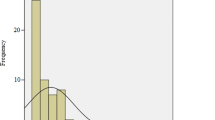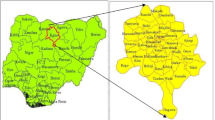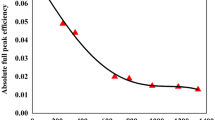Abstract
The activity concentrations of 226Ra, 232Th, and 40K in lime and gypsum samples used as building materials in Turkey were measured using gamma spectrometry. The mean activity concentrations of 226Ra, 232Th, and 40K were found to be 38 ± 16, 20 ± 9, and 156 ± 54 Bq kg − 1 for lime and found to be 17 ± 6, 13 ± 5, and 429 ± 24 Bq kg − 1 for gypsum, respectively. The radiological hazards due to the natural radioactivity in the samples were inferred from calculations of radium equivalent activities (Raeq), indoor absorbed dose rate in the air, the annual effective dose, and gamma and alpha indices. These radiological parameters were evaluated and compared with the internationally recommended limits. The experimental mass attenuation coefficients (μ/ρ) of the samples were determined in the energy range 81–1,332 keV. The experimental mass attenuation coefficients were compared with theoretical values obtained using XCOM. It is found that the calculated values and the experimental results are in good agreement.
Similar content being viewed by others
References
Ahmad, F. (2007). Natural radioactivity in building materials used in Egypt. Radiation Effects and Defects in Solids, 162, 43–52.
Alam, M. N., Miah, M. M. H., Chowdhury, M. I., Kamal, M., Ghose, S., Islam, M. N., Mustafa, M. N., & Miah, M. S. R. (1999). Radiation dose estimation from the radioactivity analysis of lime and cement used in Bangladesh. Journal of Environmental Radioactivity, 42, 77–85.
Alam, M. N., Miah, M. M. H., Chowdhury, M. I., Kamal, M., Ghose, S., & Rahman, R. (2001). Attenuation coefficients of soils and some building materials of Bangladesh in the energy range 276–1332 keV. Applied Radiation and Isotopes, 54, 973–976.
Awadallah, M. I., & Imran, M. M. A. (2007). Experimental investigation of γ-ray attenuation in Jordanian building materials using HPGe-spectrometer. Journal of Environmental Radioactivity, 94, 129–136.
Beretka, J., & Mathew, P. J. (1985). Natural radioactivity of Australian building materials, industrial wastes and by-products. Health Physics, 48, 87–95.
Berger, M. J., & Hubbell, J. (1987/1999). XCOM: Photon cross sections database, web version 1.2. Available at http://physics.nist.gov/xcom. National Institute of Standards and Technology, Gaithersburg, MD 20899, USA, 1999 (originally published as NBSIR 87-3597 “XCOM: Photon Cross Section on a Personal Computer”).
Cevik, U., & Baltas, H. (2007). Measurement of the mass attenuation coefficients and electron densities for BiPbSrCaCuO superconductor at different energies. Nuclear Instrumental Methods B, 256, 619–625.
Cevik, U., Baltas, H., Celik, A., & Bacaksız, E. (2006). Determination of attenuation coefficients, thicknesses and effective atomic numbers for CuInSe2 semiconductor. Nuclear Instrumental Methods B, 247, 173–179.
Cevik, U., Damla, N., Koz, B., & Kaya, S. (2008). Radiological characterization around Afsin-Elbistan coal-fired power plant in Turkey. Energy & Fuels, 22, 428–432.
Cevik, U., Damla, N., Kobya, A. I., Celik, N., Celik, A., & Aydın, A. A. (2009). Assessment of natural radioactivity of sand used in Turkey. Journal of Radiological Protection, 29, 61–74.
Damla, N., Cevik, U., Kobya, A. I., Ataksor, B., & Isık, U. (2009). Assessment of environmental radioactivity for Batman, Turkey. Environmental Monitoring and Assessment (in press). doi:10.1007/s10661-008-0704-9.
EC (European Commission) (1999). Radiation protection 112. Radiological protection principles concerning the natural radioactivity of building materials. Directorate-General Environment, Nuclear Safety and Civil Protection.
Fathivand, A. A., Amidi, J., & Najafi, A. (2007). The natural radioactivity in the bricks used for the construction of the dwelling in Tehran areas of Iran. Radiation Protection Dosimetry, 123, 391–393.
Fatima, I., Zaidi, J. H., Arif, M., Daud, M., Ahmad, S. A., & Tahir, S. N. A. (2008). Measurement of natural radioactivity and dose rate assessment of terrestrial gamma radiation in the soil of southern Punjab, Pakistan. Radiation Protection Dosimetry, 128, 206–212.
ICRP International Commission on Radiological Protection (1991). Recommendations of the International Commission on Radiological Protection. Annals of the ICRP, 21(1–3) (publication no. 60).
ICRP (1994). Protection against Rn-222 at home and at work. Annals of the ICRP, 23(2) (publication no. 65).
Krieger, V. R. (1981). Radioactivity of construction materials. Betonwerk Fertiteil Technik, 47, 468–473.
Kumar, V., Ramachandran, T. V., & Prasad, R. (1999). Natural radioactivity of Indian building materials and by-products. Applied Radiation and Isotopes, 51, 93–96.
Lu, X., Wang, F., Jia, X., & Wang, L. (2007). Radioactive analysis and radiological hazards of lime and cement fabricated in China. IEEE Transactions on Nuclear Science, 54, 327–332.
Lu, X., & Zhang, X. (2008). Radionuclide content and associated radiation hazards of building materials and by-products in Baoji, China. Radiation Protection Dosimetry, 128, 471–476.
Malanca, A., Pessina, V., & Dallara, G. (1993). Radionuclide content of building materials and gamma-ray dose rates in dwellings of Rio-Grande Do-Norte Brazil. Radiation Protection Dosimetry, 48, 199–203.
Ngachin, M., Garavaglia, M., Giovani, C., Kwato Njock, M. G., & Nourreddine, A. (2007). Assessment of natural radioactivity and associated radiation hazards in some Cameroonian building materials. Radiation Measurements, 42, 61–67.
OECD (1979). Exposure to radiation from the natural radioactivity in building materials. Report by a group of experts of the OECD Nuclear Energy Agency.
Righi, S., & Bruzzi, L. (2006). Natural radioactivity and radon exhalation in building materials used in Italian dwellings. Journal of Environmental Radioactivity, 88, 158–170.
Sorantin, H., & Steger, F. (1984). Natural radioactivity of building materials in Austria. Radiation Protection Dosimetry, 7, 59–61.
Stoulos, S., Manolopoulou, M., & Papastefanou, C. (2003). Assessment of natural radiation exposure and radon exhalation from building materials in Greece. Journal of Environmental Radioactivity, 69, 225–240.
Tahir, S. N. A., Jamil, K., Zaidi, J. H., Arif, M., Ahmed, N., & Ahmad, S. A. (2005). Measurements of activity concentrations of naturally occurring radionuclides in soil samples from Punjab Province of Pakistan and assessment of radiological hazards. Radiation Protection Dosimetry, 113, 421–427.
Tufail, M., Nasim-Akthar, Sabiha-Javed, & Tehsin-Hamid (2007). Natural radioactivity hazards of building bricks fabricated from saline soil of two districts of Pakistan. Journal of Radiological Protection, 27, 481–492.
Turhan, Ş. (2008). Assessment of the natural radioactivity and radiological hazards in Turkish cement and its raw materials. Journal of Environmental Radioactivity, 99, 404–414.
UNSCEAR (1993). Sources and effects of ionizing radiation. Report of the United Nations Scientific Committee on the Effects of Atomic Radiation to the General Assembly. New York: UN.
UNSCEAR (2000). Sources and effects of ionizing radiation. Report of the United Nations Scientific Committee on the Effects of Atomic Radiation to the General Assembly. New York: UN.
Author information
Authors and Affiliations
Corresponding author
Rights and permissions
About this article
Cite this article
Damla, N., Cevik, U., Kobya, A.I. et al. Assessment of natural radiation exposure levels and mass attenuation coefficients of lime and gypsum samples used in Turkey. Environ Monit Assess 170, 457–466 (2010). https://doi.org/10.1007/s10661-009-1246-5
Received:
Accepted:
Published:
Issue Date:
DOI: https://doi.org/10.1007/s10661-009-1246-5




